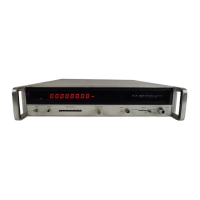Model
5340A
Theory
of
Operation
4
-
234. U3A
generates the “N Gate” qualifier for test
#2
of the program (N Gate
?
has been deter-
minted). When the count of
U6
reaches
2, U13C(6)
goes Low to drive the
Q
output of
UllA
High.
This signal
is
a
qualifier for test
#7
of the program (N
2
2
?).
BCD to decimal decoder
U28
decodes
the
A6
Search Assembly information which indicates what range the instrument is on.
U26,
27,
19,
and
20
are comparators that monitor the inverted outputs
of
U6
and
U7
and compares them
with the output of
U28.
4
-
235.
The purpose of these circuits
is
to determine if N
is
within
its
limits. There are six possible
ranges of N for the
5340A.
For
each range, the instrument selects different passive components
so
as
to obtain a particular gain for the Input Phase Lock Loop. When the instrument is in local
control or in remote control and auto range, the signal
at
U14F
pin
13
is
High, enabling the N
checking circuits. When in remote control and in a particular octave range, the input to
U14F
goes low disabling the N checking circuits. The six ranges are
as
follows:
N
64
-
256
RANGE
1
32
-
64 2
16
-
32
3
8
-
16
4
4
-
8
5
2
-
4 6
4
-
236.
A21
CONTROL
ASSEMBLY
05340
-
60021
4
-
237.
The control assembly controls the sequence of activity
as
a
measurement is being made.
Refer to Figure
5
-
3
and note that actions are required and tests are made
at
various points in the
cycle. From the test results, decisions are made and these determine the path through the flow
chart.
4
-
238. U12
is
a
single pole
16
position switch that selects the desired test and feeds the result out
on pin
10.
By placing binary
0
through
15
an input pins
11, 13, 14,
and
15, U12
selects tests
0
15.
For
example, having HHHL on pins
15,
14,
13,
and
11,
respectively, selects test
#7.
Pin
10
will then output the result of the
N
2
2
test from
XABO(R).
Note that test
#O
is connected to
common. When no test
is
desired, test
#O
is selected, giving a known output.
4
-
239.
Similarly
U13
is another single pole
16
position switch that selects one of
16
possible
actions.
For
example, placing HLHH into
U13
pins
20, 21, 22,
and
23,
respectively, will select
action
#11
by pulling
U13(13)
low. This sets flip
-
flop
U5D-U5C
to trigger one
-
shot
U9B.
C3
and
R6
control the time constant of the one
-
shot. The output of
U9B
is
fed back to the test selector
U12
because the program requires
a
test for completion of
this
delay.
U8, U5,
and
U14
are
flip
-
flops that store five of
the
outputs of
U13.
All
of
the
outputs
of
U13
are
routed
to
other
areas to initiate
a
new action.
U13(18, 19)
are connected to the clock to synchronize actions with
the clock signal.
UlOB
and
UlOA
are flip
-
flops that indicate to
U12
whether the main gate is
opened or closed. Gates
U15C
and
U15A
activate the front panel main gate annunciator
(A25DSll)
when the main gate
is
opened.
U9A
is
a one
-
shot that keeps
A25DSll
on long
enough to be visible during short gate times. Note that when no action
is
desired (for example
when
a
test
is
being made), action
#O
is
selected, which does nothing.
i
4
-
240.
Read Only Memory (ROM)
U4
is
a
storage device that will supply
a
predetermined 8
-
bit
output code for each of
32
possible input codes.
4
-
241.
For example when program address
HLLLH
is
on pins
14, 13, 12, 11,
and
10,
respectively,
the output on pins
1
through
7
will be HLLHLLLL, respectively. This will select test
#9
and action
#O
(nothing).
Other input codes similarly select other tests and actions. See
U4
Truth Table.
4
-
242. U3
is
another ROM that outputs the program address
of
the next step in Figure
5
-
3. U1
is
a
three pole two position syifch that connects, respectively, pins
12,
7,
and
4
to pins
13,
6,
and
3
or pins
14,
5,
and
2,
denending on the test result logic level on pin
1.
High selects pins
13,
6,
and
3.
The three switch lines are used with the two unswitched outputs of
U3.
The next clock pulse,
storage flip
-
flop
U2
transfers this data to ROM’s
U3
and
U4.
,
,
,!
4
-
48

